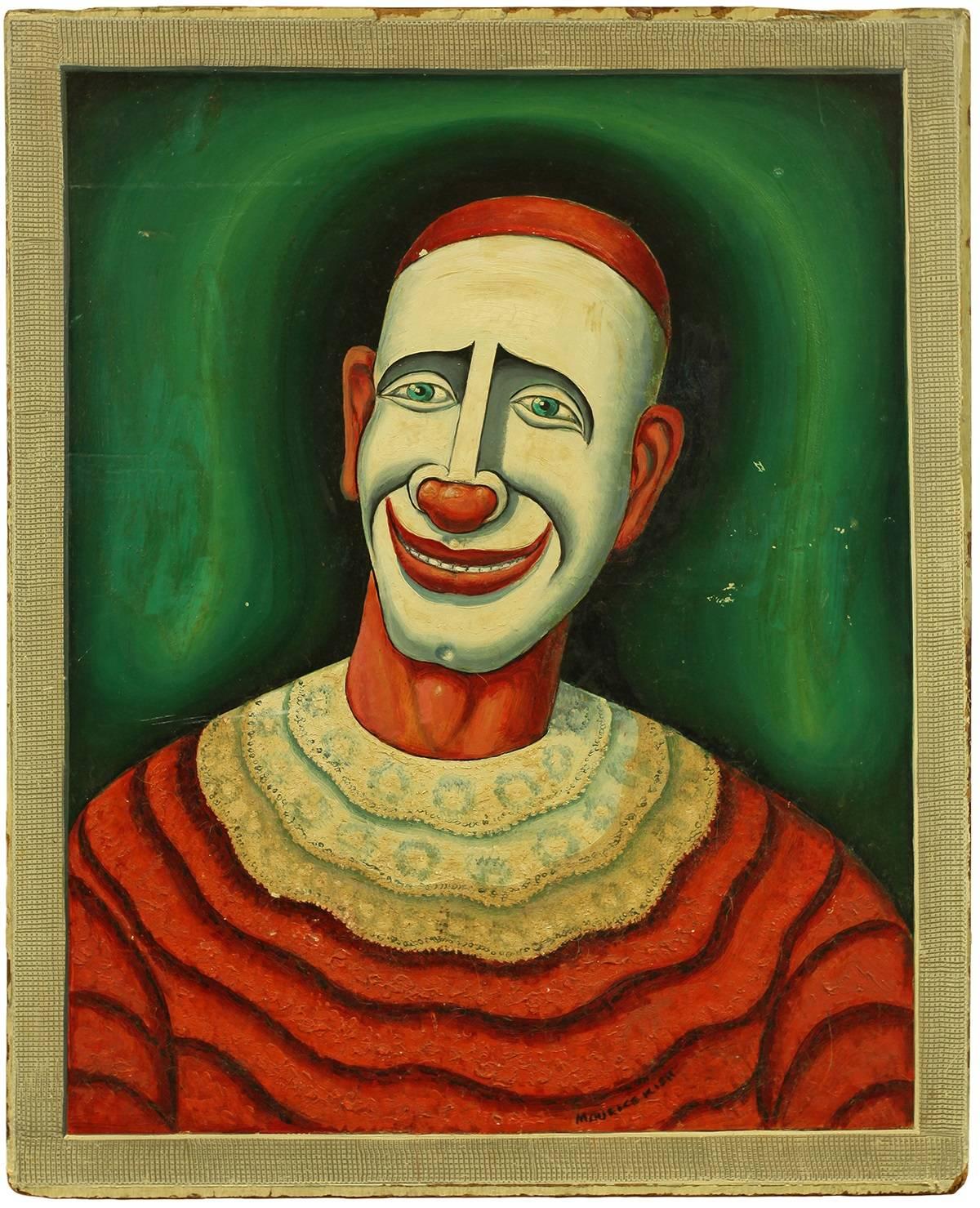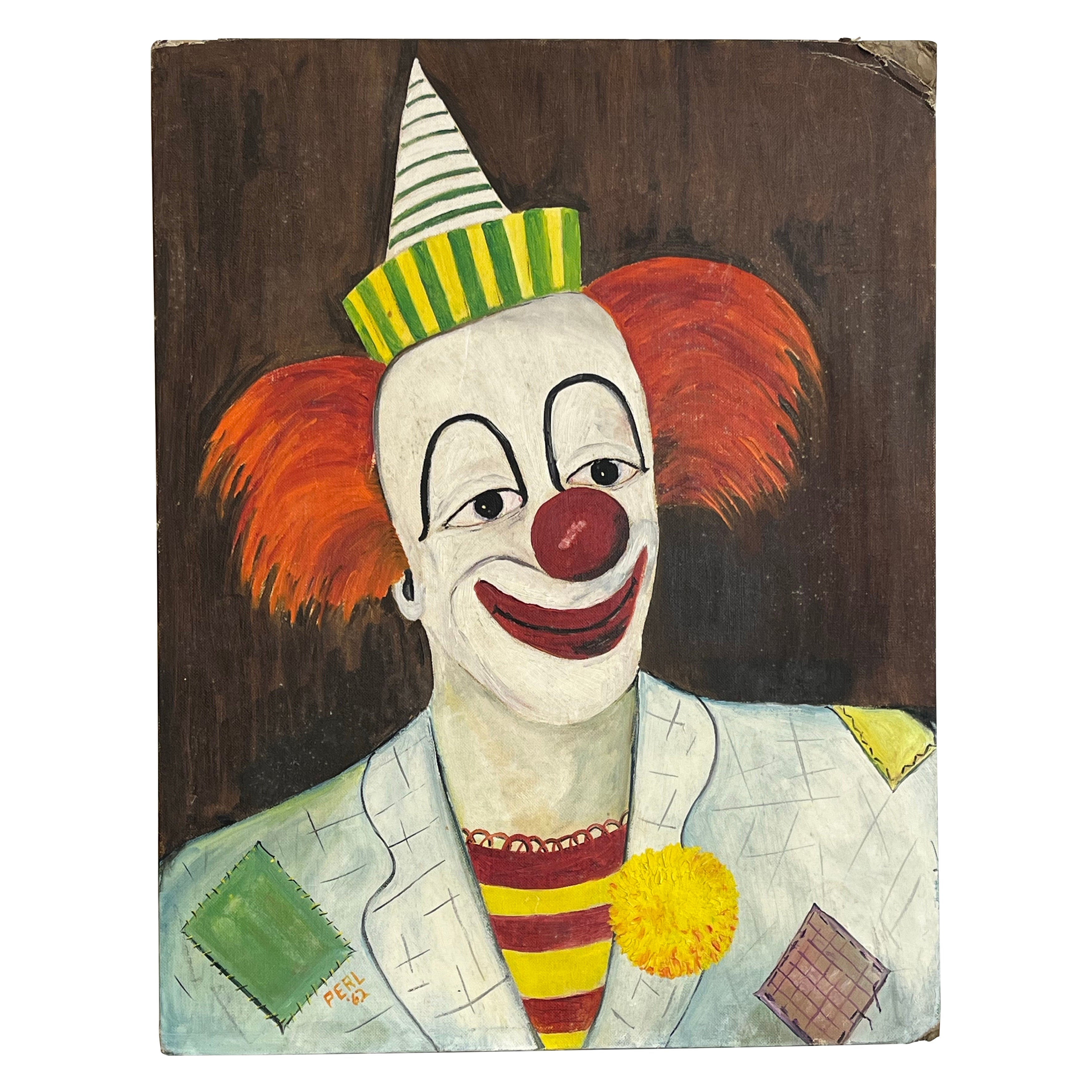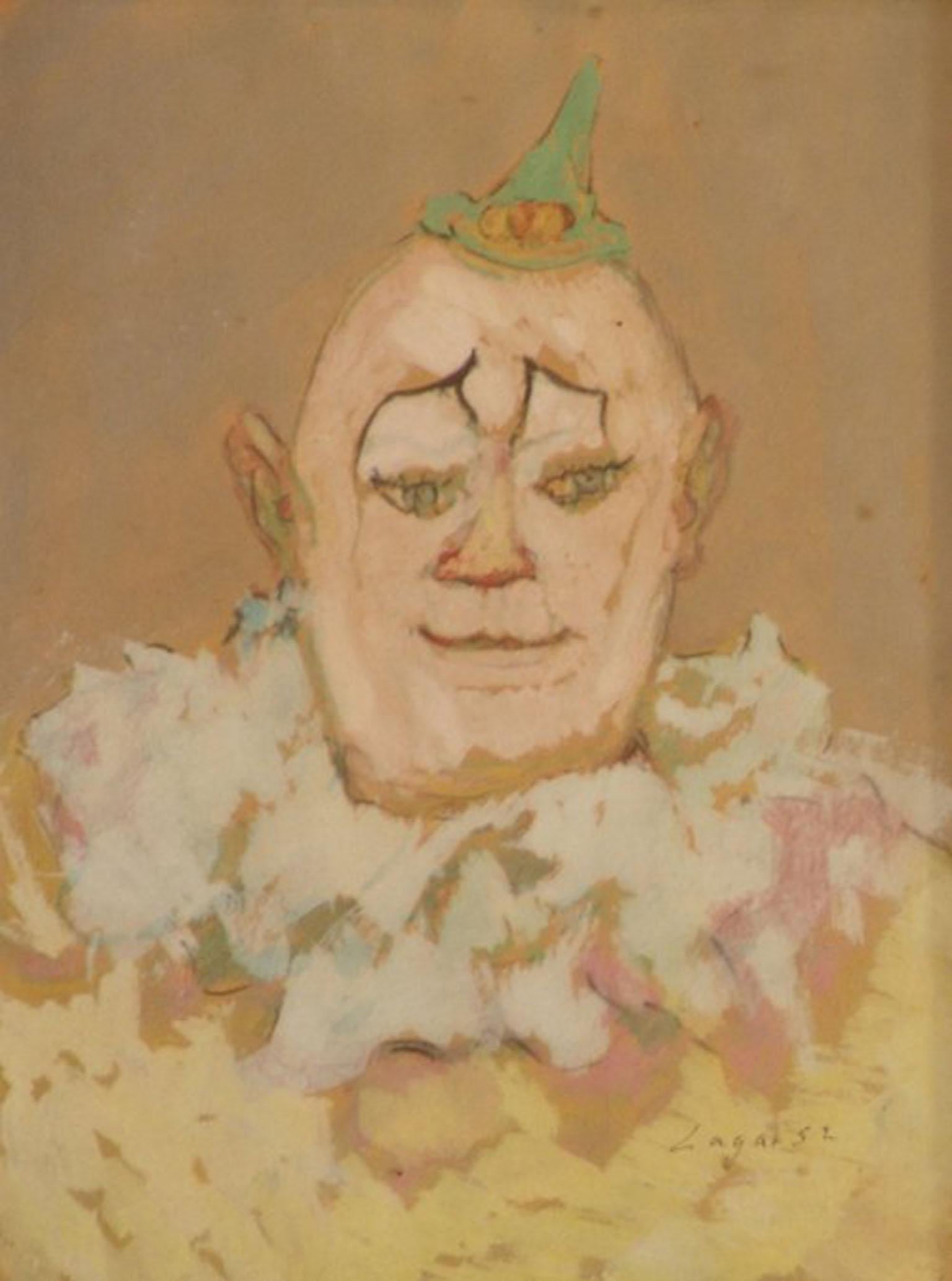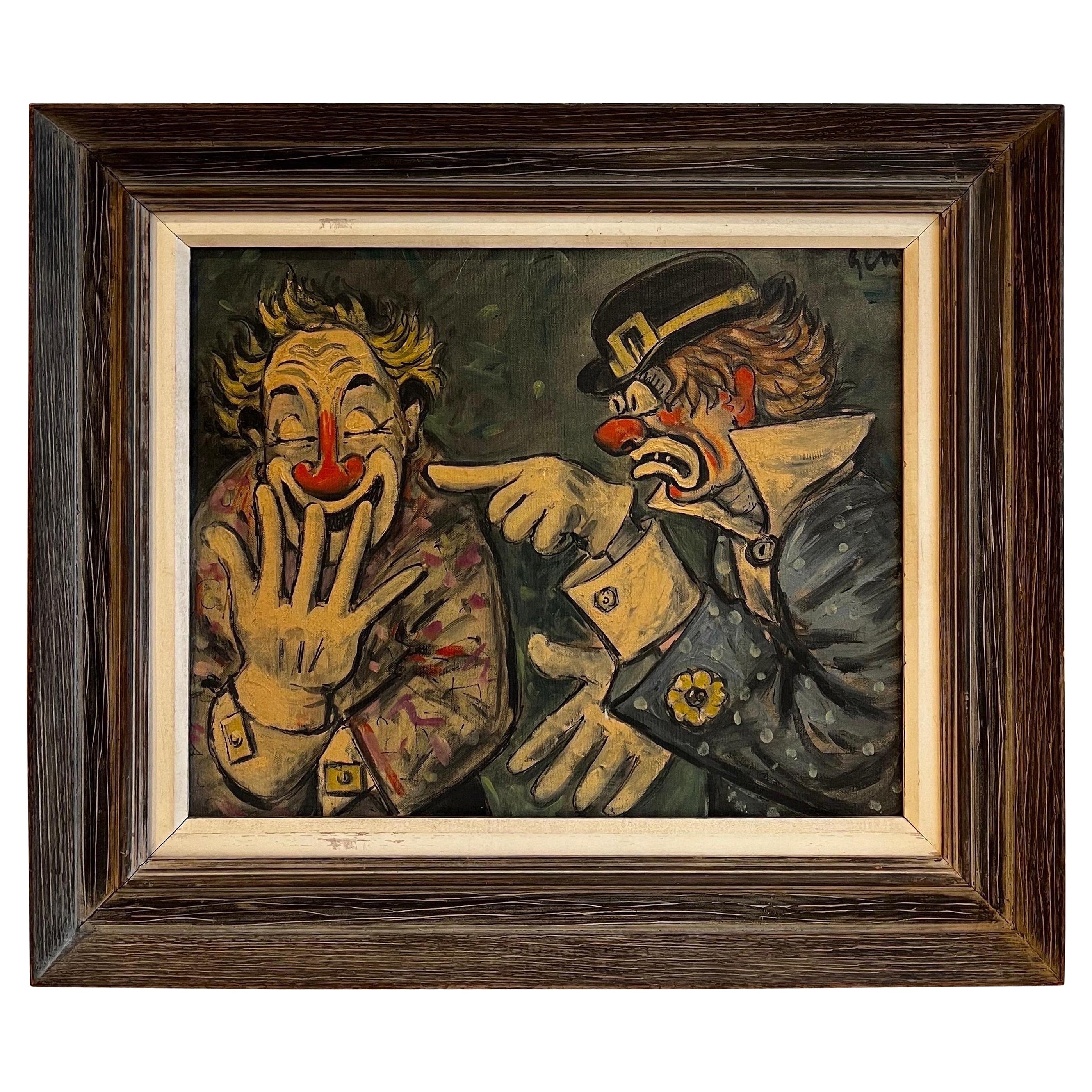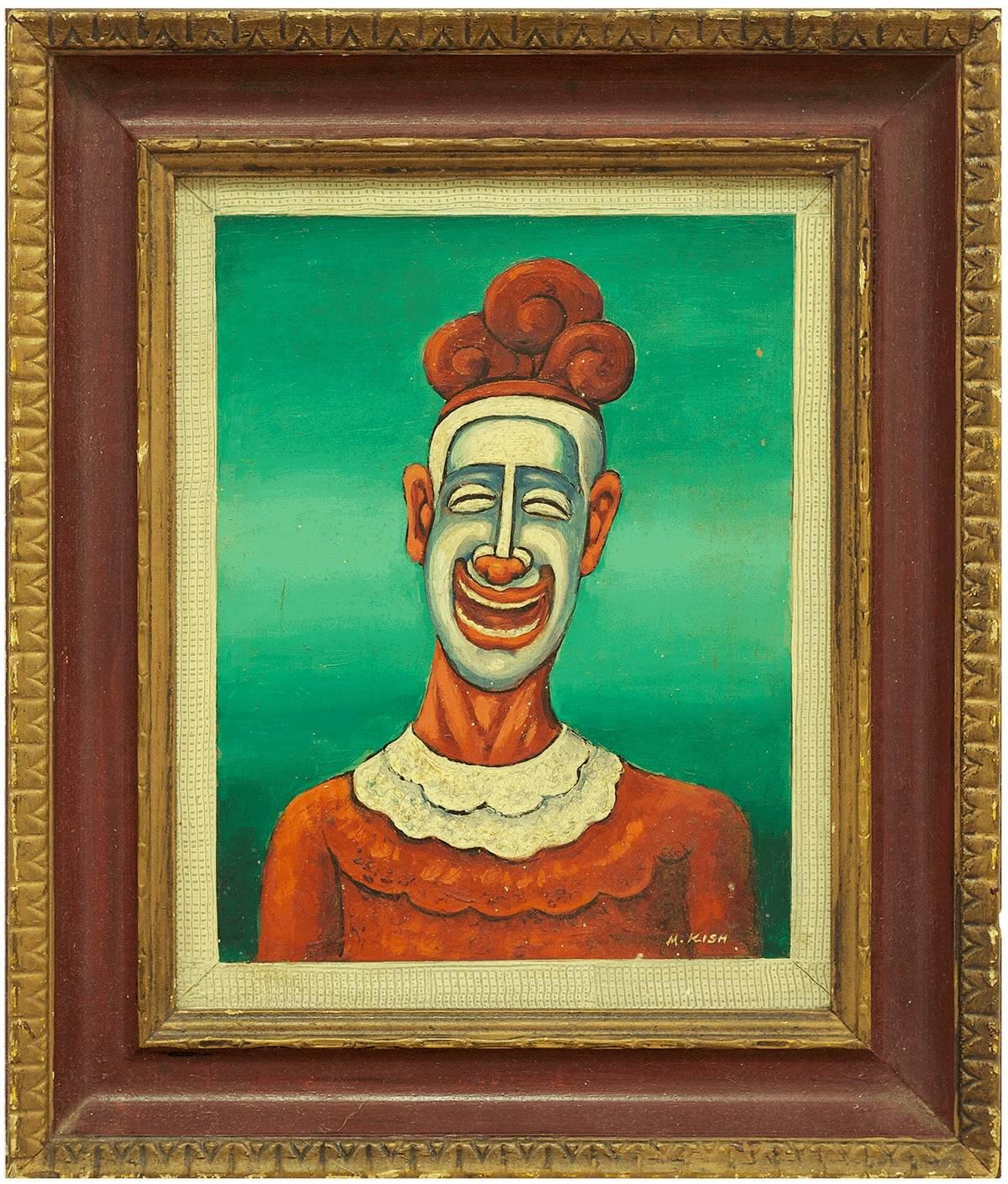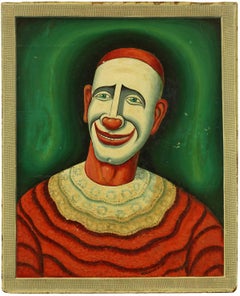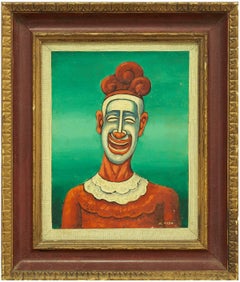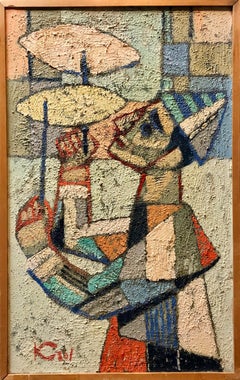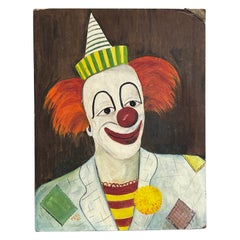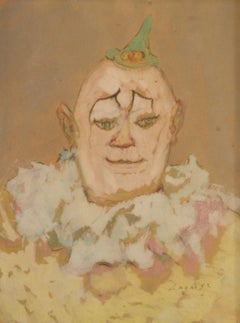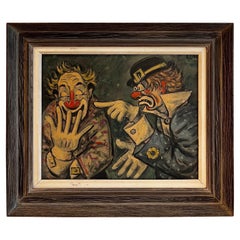Items Similar to Clown, Modernist Oil Painting on Board WPA Artist
Want more images or videos?
Request additional images or videos from the seller
1 of 7
Maurice KishClown, Modernist Oil Painting on Board WPA Artist
$1,800
£1,374.29
€1,587.98
CA$2,526.86
A$2,816.45
CHF 1,477.69
MX$34,393.42
NOK 18,710.81
SEK 17,684.56
DKK 11,851.80
About the Item
This portrait of a clown by Maurice Kish is part from a series of carnival figures, circus clowns and carousel horses and riders that he did in the 30s and 40s. The artist uses a vibrant color palette and controlled brushstrokes to depict the subject in a realistic way.
The imagery of Maurice Kish (1895-1987), whether factories or carousels, reliably subverts expectations. His vision hovers just around the unraveling edge of things, where what is solid and clear becomes ambiguous. He is fascinated, often delighted, by the falling apart. This unexpected, fresh perspective results in oddly affecting pictures of a now long-gone New York.
Born Moishe in a town called Dvinsk, Russia (what is now Daugavpils, Latvia), Kish came with his family to New York when he was in his teens. The family settled in Brownsville, and for the rest of Kish’s life Brooklyn remained his home, though he moved from one neighborhood to another. He was close to his parents, who recognized his talent and supported his desire to become an artist.
Kish attended the National Academy of Design as well as Cooper Union. His fellow students included many other immigrants and children of immigrants who were particularly receptive to the Modernism coming from Europe. As his career progressed, Kish himself applied different strains of Modernism to different purposes. For him, the story was held above all else.
For years, Kish used the skills he acquired in art school to earn his living at a Manhattan glass factory where he painted floral designs on vases. During the Depression, Kish became a WPA painter in the Federal Art Project (FAP). FAP artists were given a mandate to create works that celebrated labor. The artists tended to be socially progressive, as Kish certainly was. Kish's work from this period, with its dark colors and rolling clouds, reveals the influence of Social Realists like Thomas Hart Benton. Apparent, too, is Kish's interest in the urban monumentality of Charles Sheeler. Kish's structures, however, lack Sheeler's almost dehumanized precision. Rather than the soulless, sleek machines of a typical modern urban dystopia, Kish's factories are shaggy old beasts as worn out as the laborers who troop through their doors. In End of Day's Toil, now at the Smithsonian, the viewer feels some affection for that rambly grandfather of a building all the tired small workers are leaving behind.
Much of Kish's work, for the FAP and elsewhere, undermines received truths in a similar way. Some early works with themes from Yiddish culture are overtly humorous: a painting of a big jolly wedding guest, looking invitingly over her shoulder; a big fiddler on a small roof. Later, the humor becomes more ironic and reflective. In another work, the rather imposing organ grinder of the late 1930s looms above a child, yet his intermediary the cockatoo is bright and appealing, and offers the girl a fortune with his beak. This could read as an allegory for capitalism as easily as a straightforward colorful street scene. A small painting of a snowy day in Washington Square gives a bird's eye view of people bent against the wind walking alone or in pairs. The huge triumphal arch at the middle of it has no connection to their movements or their lives. Kish makes its size and centrality a quiet joke about the futility of grandiose gestures. Like the buildings in his FAP works, the arch has a personality. It is a landmark that looks a bit lost.
A favorite location for Kish was Coney Island. For the laborers of the city, this was a place of great freedom and possibility. There were no bosses! Anyone could go to ride the rides and swim in the sea. For Kish, Coney Island, and especially Luna Park, became a place richly symbolic of workers’ rights. For the dreamlike paintings he set there, Kish looked past the Social Realists to the Expressionists. His colors are brilliant and his lines are wild. These images, joyfully unrestrained, give full voice to an anarchic vision merely hinted at in other works. If the structures of the earlier pictures came further out of the background than expected, these Coney Island structures completely take over the scene.
Kish made several variations on the theme of the carousel as a site of revolution. In the moonlight, the horses have broken from their poles and spin away from the calm center. The workers have come to manic life, have released themselves from the yoke of labor and have abandoned their master, the merry-go-round. They escape to different corners of the pleasure park, dance together and ride the ferris wheel. One horse pretends to be a ticket seller. It is another allegory, one that depicts a worker's holiday paradise in carnival fashion.
A painter who embraced ambiguity, Kish was himself a man who occupied many worlds simultaneously. Even during the period when he had shows at prestigious galleries and belonged to several artists' groups, he identified most strongly as an outsider, a Yiddischer. He wrote poetry in Yiddish throughout his life. In 1968, he published a volume of fifty years of these poems, Di Velt ist Mayn Lid (The World is My Song) in Yiddish, with no English translation, for his peers. Kish also translated English-language poetry into Yiddish and acted as a guide to help other Yiddish writers. Long after the art organizations ceased to provide meaning and fulfillment, Kish was a devoted member of the Yiddish Culture Association.
In addition to painting and poetry, Kish was a dancer who taught during the summers at various Jewish resorts in the Catskills. Small but lithe, he also spent some years as an amateur boxer. Well into his eighties, Kish was proud of the quality of his handball game.
By the 1940s, Kish’s career was going well, but his descriptive style of working began to fall out of fashion, supplanted by a more formal Abstraction. Kish was never able to support himself solely through his art, yet in the midst of all of his other activities, Kish continued to create his distinctive images of an immigrant's New York. He departed far from the mainstream, and in later years, seldom showed his work, preferring to keep it for himself (although he sometimes traded paintings for rent).
Of making art, Kish said, "It is a sacred mission to enrich, to elevate and to make our lives more complete." His works, though frequently playful, encourage a second look at ordinary things. His irreverence elevates by revealing flaws where his audience, all workers and outsiders of a kind, can get a purchase. Kish's art fondly celebrates the beauty of the irregular.
- Creator:Maurice Kish (1895-1987, American)
- Dimensions:Height: 13.25 in (33.66 cm)Width: 11.25 in (28.58 cm)
- Medium:
- Movement & Style:
- Period:
- Condition:frame has wear, minor wear to surface, varnish and some abrasions in margins.
- Gallery Location:Surfside, FL
- Reference Number:1stDibs: LU38212773652
About the Seller
4.9
Platinum Seller
Premium sellers with a 4.7+ rating and 24-hour response times
Established in 1995
1stDibs seller since 2014
1,786 sales on 1stDibs
Typical response time: <1 hour
- ShippingRetrieving quote...Shipping from: Surfside, FL
- Return Policy
Authenticity Guarantee
In the unlikely event there’s an issue with an item’s authenticity, contact us within 1 year for a full refund. DetailsMoney-Back Guarantee
If your item is not as described, is damaged in transit, or does not arrive, contact us within 7 days for a full refund. Details24-Hour Cancellation
You have a 24-hour grace period in which to reconsider your purchase, with no questions asked.Vetted Professional Sellers
Our world-class sellers must adhere to strict standards for service and quality, maintaining the integrity of our listings.Price-Match Guarantee
If you find that a seller listed the same item for a lower price elsewhere, we’ll match it.Trusted Global Delivery
Our best-in-class carrier network provides specialized shipping options worldwide, including custom delivery.More From This Seller
View AllClown, Early 20th Century Playful Oil Painting on Board
By Maurice Kish
Located in Surfside, FL
This portrait of a clown by Maurice Kish is part from a series of carnival figures, circus clowns and carousel horses and riders that he did in the 30s and 40s. The artist uses a vibrant color palette and controlled brushstrokes to depict the subject in a realistic way.
The imagery of Maurice Kish (1895-1987), whether factories or carousels, reliably subverts expectations. His vision hovers just around the unraveling edge of things, where what is solid and clear becomes ambiguous. He is fascinated, often delighted, by the falling apart. This unexpected, fresh perspective results in oddly affecting pictures of a now long-gone New York.
Born Moishe in a town called Dvinsk, Russia (what is now Daugavpils, Latvia), Kish came with his family to New York when he was in his teens. The family settled in Brownsville, and for the rest of Kish’s life Brooklyn remained his home, though he moved from one neighborhood to another. He was close to his parents, who recognized his talent and supported his desire to become an artist.
Kish attended the National Academy of Design as well as Cooper Union. His fellow students included many other immigrants and children of immigrants who were particularly receptive to the Modernism coming from Europe. As his career progressed, Kish himself applied different strains of Modernism to different purposes. For him, the story was held above all else.
For years, Kish used the skills he acquired in art school to earn his living at a Manhattan glass...
Category
Early 20th Century Modern Portrait Paintings
Materials
Oil, Board
The Clown N.2 (In Green)
By Maurice Kish
Located in Surfside, FL
The imagery of Maurice Kish (1895-1987), whether factories or carousels, reliably subverts expectations. His vision hovers just around the unraveling edge of things, where what is solid and clear becomes ambiguous. He is fascinated, often delighted, by the falling apart. This unexpected, fresh perspective results in oddly affecting pictures of a now long-gone New York.
Born Moishe in a town called Dvinsk, Russia (what is now Daugavpils, Latvia), Kish came with his family to New York when he was in his teens. The family settled in Brownsville, and for the rest of Kish’s life Brooklyn remained his home, though he moved from one neighborhood to another. He was close to his parents, who recognized his talent and supported his desire to become an artist.
Kish attended the National Academy of Design as well as Cooper Union. His fellow students included many other immigrants and children of immigrants who were particularly receptive to the Modernism coming from Europe. As his career progressed, Kish himself applied different strains of Modernism to different purposes. For him, the story was held above all else.
For years, Kish used the skills he acquired in art school to earn his living at a Manhattan glass...
Category
20th Century Modern Portrait Paintings
Materials
Oil, Board
Polish French Ecole de Paris Mid Century Modernist Oil Painting Clown Juggler
By Abram Krol
Located in Surfside, FL
Abram Abraham Krol was born January 22, 1919, in Pabianice (Lodz), Poland.
Abram Krol went to France in 1938 to study civil engineering at the Universit...
Category
1950s Modern Figurative Paintings
Materials
Canvas, Oil
Polish French Ecole de Paris Mid Century Modernist Oil Painting Clown Juggler
By Abram Krol
Located in Surfside, FL
Abram Abraham Krol was born January 22, 1919, in Pabianice (Lodz), Poland.
Abram Krol went to France in 1938 to study civil engineering at the University of Caen. In 1939 at the be...
Category
1950s Modern Figurative Paintings
Materials
Canvas, Oil
French 1961 "Clown a la Colerette" Figurative Expressionist Oil Painting
By Claude Weisbuch
Located in Surfside, FL
WEISBUCH, Claude. Oil on Canvas "Clown a la Colerette" 1961. Signed lower right, further signed, titled and dated verso. Dimensions: 18.25" high x 24" wide.
Claude Weisbuch, 1927-2014 French painter, draftsman and engraver. He studied at the Ecole des Beaux-Arts (School of Fine Arts) in Nancy and upon graduation became a professor of engraving at the Ecole des Beaux-Arts de of St. Etienne. His first solo exhibition was in 1957.
In 1968 , he became a full member of the Society of French Painters-Engravers .
In 1997 he was awarded the Legion of Honor
His work is essentially devoted to engraving, by which he likes to translate, thanks to the line, the life, movement and character of his characters: Punchinels, harlequins, musicians or equestrian scenes. He practices various techniques ( lithography, drypoint etching etc.) that he puts to use in the illustration of bibliophile books.
Claude Weisbuch is also a painter and draftsman. His favorite colors are ochres, browns and whites, with which he seeks to introduce the effects of light by compositions where the line and finesse of the drawing preserve the life found in his engravings.
His precise and dynamic line delivers a moving and swirling work on themes he loves: theater, opera, equestrian, musicians, card players, Kabuki dancers and many portraits.
His works have the appearance of unfinished sketches mixing few colors but a great vivacity of the line. He illustrated many limited edition signed fine art books. Alon with Christo, Arman and Cesar he is considered among the great post war French artists of the last generation.
Exhibitions
1957: Saint Placide Gallery, paintings and engravings
1958: Galerie de Presbourg, Paris, paintings - Saint Placide Gallery, Paris, paintings - Galerie des Arts, Nancy, etchings
1960: Galerie Hervé, "Extraordinary Pantomimes", Paris, paintings
1961: Salon of the young painting and painters witnesses of their time
1962: O'Hanna Gallery, London , paintings
1963: Galerie Hervé, "Portrait Of Man", Paris, Paintings - Nichido Gallery, Tokyo, Paintings
1965: Hervé Gallery, "100 Drawings", Paris Dresdener Gallery, Toronto, paintings
1966: Dantesca Gallery, Turin , paintings, engravings, drawings
1968: New Vision Gallery, Paris, engravings
1969: Galerie Hervé, Paris, paintings - Galerie Reflets, Brussels , prints, paintings - Galerie Dresder, Montreal , paintings
1970: Taménaga Gallery, Tokyo, paintings - Sagot Gallery - The Garrec, Paris, etchings - Museum of Modern Art of the City of Paris ARC, Paris, prints 5
1971: War Gallery, Avignon , etchings Biennial of Engraving, Epinal
1972: Dantesca Gallery, Turin Festival, Sarlat , paintings
1973: Wayss Gallery, Nancy , paintings, engravings, drawings Auguste Comte Gallery, Lyon , paintings, engravings, drawings Taménaga Gallery, Tokyo, paintings - New Vision Gallery, "Homage to Rembrandt", Paris, etchings
1974: Esthetika Gallery, Kortrijk, engravings - Galerie Hervé Odermatt, Paris, paintings Ésthetika Gallery, Kurne, prints - Galerie Wayss, Nancy, engravings, drawings, pastels Dietesheim Gallery, Neuchâtel , engravings - Grafikhuset Gallery, Stockholm , prints, drawings
1975: Schwarzer Gallery, Vienna , engravings, paintings, drawings Fogola Gallery, Turin, drawings, pastels Sotheby-Parke Benett, Munich, engravings, drawings Hervé Odermatt Gallery, Paris, drawings Joly Gallery, Washington , engraving
1976: Taménaga Gallery, Tokyo, paintings - Wayss Gallery, Nancy, engravings, drawings - Tabula Gallery, Tübingen, engravings, drawings - New Vision Gallery, "The horse-The painter and his model", Paris, drawings, engravings
1977: Grafikhuset, Futura, Stockholm - Jivô Gallery, Vänersborg Pigalle Gallery, Norrköping Celsius Gallery, Uppsala Möbius Gallery, Gothenburg - New Vision Gallery, Jerusalem - Cultural Center of Sainte-Menehould Castle, retrospective, engravings
1978: David Barnett Gallery, Milwaukee , engravings, drawings Orangery Gallery, Cologne , engravings, drawings, pastels Grafikhuset Futura, Stockholm, paintings, drawings Les Cordeliers, Châteauroux, engravings, drawings, paintings House of Culture, Montbéliard, engravings House of Culture, Chelles , engravings, paintings, drawings
1979: L'Empreinte Gallery, Strasbourg, prints, drawings - Galerie Reflets, Brussels, prints, drawings - Galerie Bon à tirer, Los Angeles , prints, pastels
1980: Hervé Odermatt Gallery, Paris, "Calligraphy of the figure", paintings - E. Gollon Gallery, Saint-Paul-de-Vence
1981: European Biennale of Engraving, Baden-Bade Galerie The Art Shop, Nice Galerie Hélène Trintignant, Montpellier Martine Remy Gallery, Strasbourg
1982: Vallen Gallery, Stockholm - Sagot Gallery - The Garrec, Paris - Taménaga Gallery, Tokyo, paintings - New Vision Gallery, Tokyo, Nagoya, Osaka, etchings
1983: Hélène Trintignant Gallery, Montpellier
1984: Perrine Museum, Laval , etchings - Music Festival, Quimper , etchings Etchings, Moscow - Presence Gallery, Brussels, paintings, etchings
1985: Galerie Moyon-Avenard, Nantes, paintings - Taménaga Gallery, Paris, paintings - New Otani Hotel, Ōsaka, realization of murals
1986: Taménaga Gallery, Tokyo, paintings - Greenhouse of the School of Fine Arts, Saint-Étienne , paintings, engravings
1988: Retrospective paintings, Château de Chenonceau Retrospective engravings, Artothèque Museum Montpellier Taménaga Gallery, Paris, drawings, pastels New Vision Gallery, Tokyo, engravings
1989: Galerie Taménaga, Paris, paintings
Exit of the book Weisbuch , texts of Jean-Denis Bredin of the French Academy, preface by Jean-Marie Tasset.
1990: Taménaga Gallery, Paris, paintings
1992: Retrospective, Sarlat - Taménaga Gallery, Paris, drawings
1993: Taménaga Gallery, Tokyo and Osaka
1994: Paintings for the second international meetings of the cello ensemble, Beauvais - Elegance Gallery, Taipei - Sanbi Gallery, Tokyo, graphic works - Mitsukoshi, Tōkyō
1995: Taménaga Gallery, Ōsaka - Exhibition of the Gobelins Municipal Circle, Paris 13 th
1996: 2nd Music Trades Fair, Premonstratensian Abbey , Pont-à-Mousson , paintings - Ginza Spring, Tokyo, paintings - New Otani Museum, Tokyo, paintings
1997: Galerie Raugraff, Nancy, paintings, pastels, drawings, engravings, lithographs - Theater Gallery, Besançon, paintings, drawings, engravings, lithographs
1999: A retrospective "Weisbuch, 50 years of prints", 230 works exhibited in Strasbourg under the direction of its publisher, L'Estampe Éditions 3 - Taménaga Gallery, Paris, Tōkyō
2000: Retrospective Château de Vascœuil , by L'Estampe - Theater Gallery, Besançon , paintings, drawings, engravings, pastels, lithographs - Retrospective Chamber of Commerce, Strasbourg - engravings (retrospective), Jacques Brel cultural center, Thionville - engravings (retrospective ), chamber of commerce, Nancy
2001: Retrospective Orangerie of Madame Élisabeth, Versailles , paintings
2002: Taménaga Gallery "Movements", Paris
2003: L'Estampe Gallery, in partnership with the Theater Gallery - prints and paintings, Besançon
2004: Taménaga Gallery "Prometheus presenting the secret of fire to humans", Paris Crid'Art Gallery, L'Estampe Gallery, Amnéville-les-Thermes , paintings, prints, drawings, prints - Galerie des Arts, Nîmes , paintings
2010: Galerie125, Argancy , recent works, exhibition of 100 recent works by the artist.
2012: Exhibition at the Château de Malbrouck . More than 150 works by the artist. Organized by the General Council of Moselle and L'Estampe (editor Claude Weisbuch).
2012: Print, Strasbourg, paintings, engravings, drawings
2012: Exhibition at the House of wines of Graves de Podensac in Gironde. 150 works by the artist Event organized by Course N ° 3.
2013: Galerie125, Argancy, "Weisbuch, major works", exhibition of drawings, engravings, lithographs and oils on canvas
2014: Galerie125, Argancy, "Weisbuch, from 1947 to 1960", exhibition of 100 ancient engravings...
Category
1960s Modern Figurative Paintings
Materials
Canvas, Oil
The Happy Inlaw, Oil Painting
By Maurice Kish
Located in Surfside, FL
The imagery of Maurice Kish (1895-1987), whether factories or carousels, reliably subverts expectations. His vision hovers just around the unraveling edge of things, where what is solid and clear becomes ambiguous. He is fascinated, often delighted, by the falling apart. This unexpected, fresh perspective results in oddly affecting pictures of a now long-gone New York.
Born Moishe in a town called Dvinsk, Russia (what is now Daugavpils, Latvia), Kish came with his family to New York when he was in his teens. The family settled in Brownsville, and for the rest of Kish’s life Brooklyn remained his home, though he moved from one neighborhood to another. He was close to his parents, who recognized his talent and supported his desire to become an artist.
Kish attended the National Academy of Design as well as Cooper Union. His fellow students included many other immigrants and children of immigrants who were particularly receptive to the Modernism coming from Europe. As his career progressed, Kish himself applied different strains of Modernism to different purposes. For him, the story was held above all else.
For years, Kish used the skills he acquired in art school to earn his living at a Manhattan glass...
Category
20th Century Folk Art Figurative Paintings
Materials
Oil, Board
You May Also Like
Mid Century Clown Painting on Board Perl '62
Located in W Allenhurst, NJ
Great whimsical mid century painting of a clown. Period attire with big expression. Signed Perl '62
Category
Vintage 1960s Unknown Mid-Century Modern Paintings
Materials
Paint
Oil painting of Clown
Located in Fredericksburg, VA
This is a painting done by the American artist L.A. McMillen. It is signed lower right and is in excellent condition for the period. This shows a clown scene with the face of a man i...
Category
Early 20th Century Surrealist Figurative Paintings
Materials
Canvas, Oil
"The Clown", 20th Century Gouache on Cardboard by Spanish Artist Celso Lagar
By Celso Lagar
Located in Madrid, ES
CELSO LAGAR
Spanish, 1891 - 1966
THE CLOWN
signed and dated "Lagar 52" (lower right)
gouache on cardboard
10-5/8 x 8 inches (27 x 20.5 cm.)
PROVENANCE
Private French Collector
Cel...
Category
1950s Fauvist Portrait Paintings
Materials
Gouache, Cardboard
Expressive Clown Painting, signed, c. 1950
Located in Philadelphia, PA
Expressive clown painting - signed "Jen"
circa 1950 - great frame
Frame size = 22.5 x 26.5
Image size = 15.5 x 19.5.
Category
Mid-20th Century American Mid-Century Modern Paintings
Materials
Paint
$750 Sale Price
60% Off
European Artist. Oil on board. Portrait of a clown. Dated 1962
Located in København, Copenhagen
European Artist.
Oil on board.
Portrait of a clown.
Expressionist style with impasto strokes. Colouristic palette.
Dated 1962 on the back.
Indistinctly signed.
In perfect condition.
...
Category
Vintage 1960s Unknown Modern Paintings
Materials
Other
Peter Keil Oil On Canvas, 'The Clown' Painting
By Peter Keil
Located in Bradenton, FL
Oil on canvas painting was painted by German/American artist Peter Keil (born 1942). Original expressionist portrait of "The Clown." The painting is signed and dated on the reverse (...
Category
Mid-20th Century German Mid-Century Modern Contemporary Art
Materials
Canvas
More Ways To Browse
For Rent
Wedding Painting
Wedding In Paintings
Jewish Russian Painting
English Painting Child
Antique Round Painting
Antique Oil Painting On Glass
Portrait Of Maurice
Antique Bird Oil Painting
Early 20th Century Childrens Portrait
Portrait Of Clown
Painted Game Board
Circus Clown Art
Dark Floral Oil Painting
Floral And Birds Paintings
Maurice Eyer
1930s Circus Art
Carnival Glass Glass
